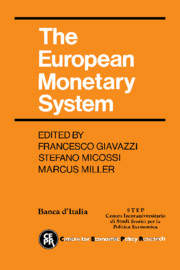Book contents
- Frontmatter
- Contents
- List of figures
- List of tables
- Preface
- Conference participants
- 1 Introduction
- I THE INTERNATIONAL ENVIRONMENT
- II DISINFLATION, EXTERNAL ADJUSTMENT AND COOPERATION
- 4 The role of the exchange-rate regime in a disinflation: empirical evidence on the European Monetary System
- 5 Inflation and the European Monetary System
- 6 Economic growth and exchange rates in the European Monetary System: their trade effects in a changing external environment
- III EXCHANGE RATES, CAPITAL MOBILITY AND MONETARY COORDINATION
- IV THE FUTURE OF THE EUROPEAN MONETARY SYSTEM
- 12 The European Monetary System: a long-term view
- 13 A new phase in the European Monetary System - exchangerate constraint, capital liberalisation and policy coordination: a report of the conference panel discussion
- Index
13 - A new phase in the European Monetary System - exchangerate constraint, capital liberalisation and policy coordination: a report of the conference panel discussion
Published online by Cambridge University Press: 12 March 2010
- Frontmatter
- Contents
- List of figures
- List of tables
- Preface
- Conference participants
- 1 Introduction
- I THE INTERNATIONAL ENVIRONMENT
- II DISINFLATION, EXTERNAL ADJUSTMENT AND COOPERATION
- 4 The role of the exchange-rate regime in a disinflation: empirical evidence on the European Monetary System
- 5 Inflation and the European Monetary System
- 6 Economic growth and exchange rates in the European Monetary System: their trade effects in a changing external environment
- III EXCHANGE RATES, CAPITAL MOBILITY AND MONETARY COORDINATION
- IV THE FUTURE OF THE EUROPEAN MONETARY SYSTEM
- 12 The European Monetary System: a long-term view
- 13 A new phase in the European Monetary System - exchangerate constraint, capital liberalisation and policy coordination: a report of the conference panel discussion
- Index
Summary
Introductory statement
It will be a useful introduction to this policy panel if I briefly recall the changes in the EMS mechanisms recently decided upon by the Committee of Governors of the EEC, the considerations that led the Governors to adopt them, and the underlying analytical framework.
Changes in the environment and their impact on EMS mechanisms
The good performance of the EMS has been due above all to the policies of its members, notably their willingness to take account of the requirements of the exchange-rate constraint in setting domestic objectives.
The EMS has also benefited, however, from certain factors and circumstances whose influence may be less favourable in the future. In fact:
(a) As long as the dollar was strong and expected to remain strong, capital flows from Europe to the US tended to depress the DM relative to the other EMS currencies, and to strengthen EMS cohesion because of the DM's role as a dollar substitute in international portfolios. The opposite has occurred since the dollar started to decline: weakness in the dollar has caused strains and tended to amplify tensions generated within the EMS by divergences in economic performances and policies.
(b) The acceleration of financial integration and the removal of many of the exchange controls in France and Italy have increased capital mobility in Europe. As a result, the external constraint on domestic policies has become more stringent and the potential repercussions on exchange rates of divergent monetary conditions in EMS countries have been enhanced.
(c) While inflation differentials have narrowed to their lowest values since the late 1960s, there remain significant differences between EMS countries in fiscal positions as well as in unemployment, demographic trends, and potential GDP growth.
[…]
- Type
- Chapter
- Information
- The European Monetary System , pp. 385 - 418Publisher: Cambridge University PressPrint publication year: 1988

